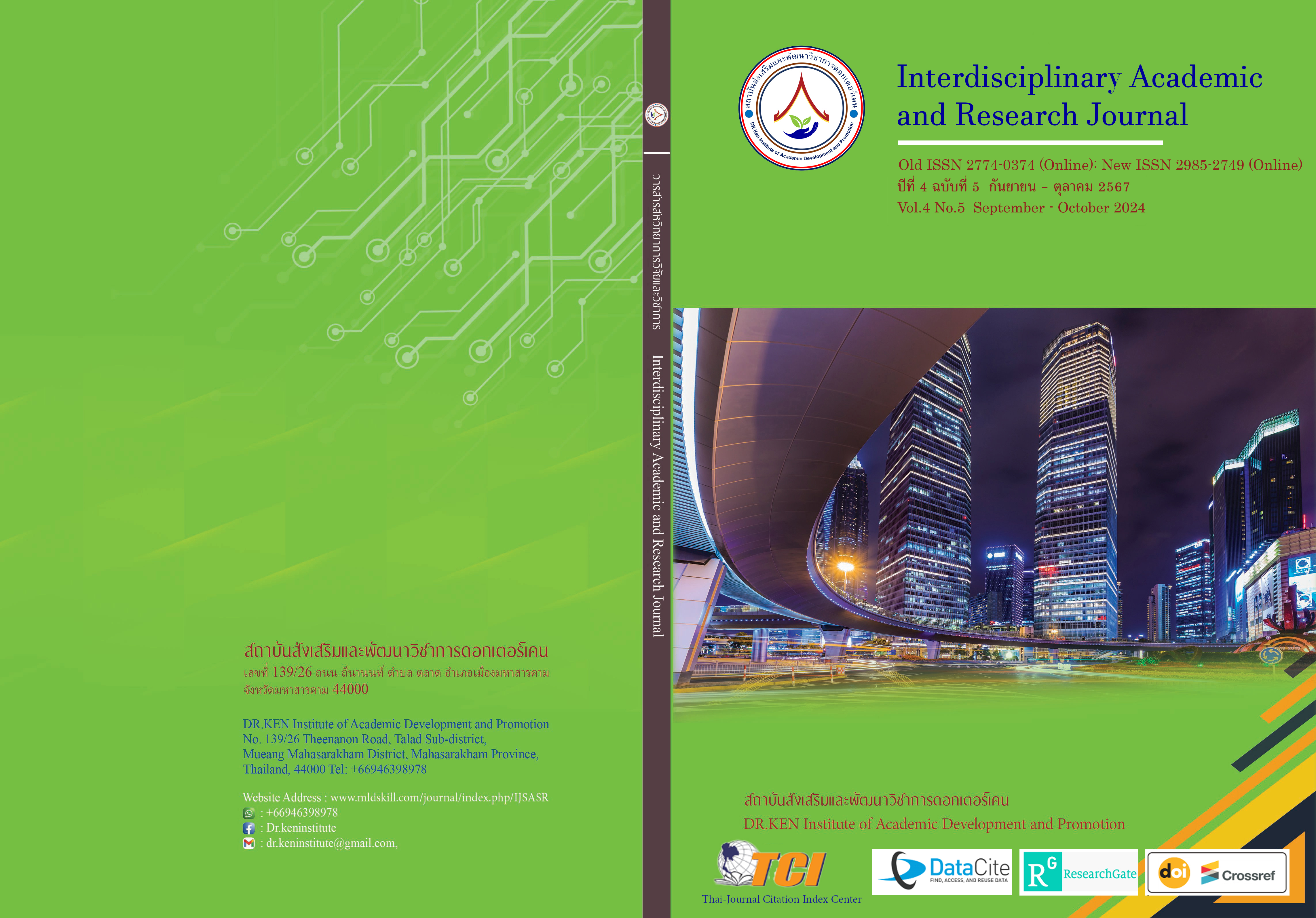The Development of Science Learning Activities Package followed Inquiry-Based Learning for Primary School Students in Pathum Thani Province
DOI:
https://doi.org/10.60027/iarj.2024.282613Keywords:
Teaching Science; , Science Board Games; , Learning PackageAbstract
Background and Aims: Teaching game techniques have been known to teachers for a long time and remain effective today. There are many types of games, but board games are currently popular. Board games are widely used in various subjects, including science because game designers can create mechanisms that train and develop students in diverse ways. This research aims to: 1) develop the science learning activities package following inquiry-based learning for primary school students in Pathum Thani province, 2) to evaluate the effectiveness of the science learning activities package following inquiry-based learning for primary school students in Pathum Thani province, according to the 75/75 standard criteria. and 3) study the consequences of using the science learning activities package followed by inquiry-based learning for primary school students in Pathum Thani Province to improve academic achievement and scientific process skills for elementary students in Pathum Thani Province.
Methodology: The target group for this research consists of students from small, medium, and large elementary schools in Pathum Thani Province, selected through purposive sampling. The research tools include the science learning activities package followed by inquiry-based learning for primary school students in Pathum Thani province. Data collection instruments include 1) an academic achievement test, 2) a scientific process skills assessment, and 3) a satisfaction questionnaire regarding the science learning activities. Statistical methods used for data analysis include percentage, mean, standard deviation, and t-test.
Results: 1) The efficiency of the science learning activities package followed by inquiry-based learning for primary school students in Pathum Thani province was found to be (E1/E2) 81.66/75.50, which is higher than the established efficiency criteria of 75/75. 2) The academic achievement of students who engaged in the science learning activities package followed inquiry-based learning for primary school students in Pathum Thani province was significantly higher after the learning activities compared to before, at a significance level of .05. and 3) The scientific process skills of students who participated in the science learning activities package followed inquiry-based learning for primary school students in Pathum Thani province were overall at a high level. 4) The overall satisfaction of students with the science learning activities package followed by inquiry-based learning for primary school students in Pathum Thani province was at the highest level. When considering individual aspects, content, learning activities, and the benefits gained from the activities were all rated at the highest level.
Conclusion: The science learning activity package, combined with the use of board games, integrates multimedia that can enhance students' learning outcomes. Additionally, board games can spark interest in the subject matter and help connect students with complex scientific content or skills.
References
กระทรวงศึกษาธิการ. 2551. หลักสูตรแกนกลางการศึกษาขั้นพื้นฐาน พุทธศักราช 2551. กรุงเทพฯ: โรงพิมพ์สหกรณ์การเกษตรแห่งประเทศไทย จำกัด.
กระทรวงศึกษาธิการ. 2560. ตัวชี้วัดและสาระการเรียนรู้แกนกลาง กลุ่มสาระการเรียนรู้วิทยาศาสตร์ (ฉบับปรับปรุง พ.ศ. 2560) ตามหลักสูตรแกนกลางการศึกษาขั้นพื้นฐาน พุทธศักราช 2551.กรุงเทพฯ: โรงพิมพ์สหกรณ์การเกษตรแห่งประเทศไทย จำกัด.
กฤตฏ์ ชมพูวิเศษ และพัชรินทร์ ชมภูวิเศษ. (2563). การศึกษาผลสัมฤทธิ์ทางการเรียนทักษะกระบวนการทางวิทยาศาสตร์และความพึงพอใจโดยการจัดการเรียนรู้ด้วยชุดกิจกรรมการเรียนรู้สำหรับนักเรียนชั้นมัธยมศึกษาปีที่ 2. วารสารวิชาการและวิจัยสังคมศาสตร์. 15 (2), 29-42.
กิดานันท์ มลิทอง. (2543). เทคโนโลยีการศึกษาและนวัตกรรม. (พิมพ์ครั้งที่2). กรุงเทพ: จุฬาลงกรณ์มหาวิทยาลัย.
จักรกฤษณ์ โพดาพล. (2563). การจัดการเรียนรู้ออนไลน์: วีถีที่เป็นไปทางการศึกษา. เลย: มหาวิทยาลัยมหามกุฎราชวิทยาลัย.
ชัยยงค์ พรหมวงศ์. (2556). การทดสอบประสิทธิภาพสื่อหรือชุดการสอน. วารสารศิลปากรศึกษาศาสตร์วิจัย. 5 (1), 7-20.
ถนอมพร เลาหจรัสแสง. (2541). คอมพิวเตอร์ช่วยสอน. กรุงเทพฯ : ศูนย์หนังสือแห่งจุฬาลงกรณ์ มหาวิทยาลัย.
บุญชม ศรีสะอาด. (2551). การวิจัยสําหรับครู. กรุงเทพฯ : สุวิริยาสาสน .
พิมพันธ์ เดชะคุปต์ และ พเยาว์ ยินดีสุข. 2555. การจัดการเรียนรู้ในศตวรรษที่ 21. กรุงเทพฯ: จุฬาลงกรณ์มหาวิทยาลัย.
มนัสนันท์ หัตถศักดิ์ และรัชกร เวชวรนันท์. (2565).การพัฒนาบอร์ดเกมเพื่อส่งเสริมการเรียนรู้การจัดการชั้นเรียนของนิสิตคณะศึกษาศาสตร์ มหาวิทยาลัยเกษตรศาสตร์. วารสารมนุษยศาสตร์วิชาการ, 29(2), 106-126.
ราชบัณฑิตยสถาน. (2551). พจนานุกรมศัพท์พอลิเมอร์ ฉบับราชบัณฑิตยสถาน ราชบัณฑิตยสถาน พ.ศ.2551. กรุงเทพฯ: ราชบัณฑิตยสถาน.
วรรณิภา พรหมหาราช. (2564). การจัดการเรียนรู้ด้วยกระบวนการสืบเสาะหาความรู้ 5 ขั้น ร่วมกับบอร์ดเกม เรื่อง พันธะเคมีเพื่อพัฒนาทักษะการแก้ปัญหาของนักเรียนชั้นมัธยมศึกษาปีที่ 4. ครุมหาบัณฑิต (วิทยาศาสตร์ศึกษา) มหาวิทยาลัยราชภัฎมหาสารคาม.
วิษณุ สุทธิวรรณ. (2562). การพัฒนาผลสัมฤทธิ์ทางการเรียนวิชาวิทยาศาสตร์โดยใช้ชุดกิจกรรมการเรียนรู้ประกอบการสอนแบบสืบเสาะหาความรู้ (5Es) เรื่อง ลม ฟ้า อากาศของนักเรียนชั้นประถมศึกษาปีที่ 5/2 โรงเรียนเทศบาลท่าโขลง 1. วารสารการบริหารนิติบุคคลและนวัตกรรมท้องถิ่น, 6(1), 1-13.
สกุล สุขศิริ. (2550). ผลสัมฤทธิ์ของสื่อการเรียนรู้แบบ Game Based Learning. กรุงเทพฯ: สถาบัน. บัณฑิตพัฒนบริหารศาสตร์.
สถาบันส่งเสริมการสอนวิทยาศาสตร์และเทคโนโลยี. (2555). การวัดผลประเมินผลวิทยาศาสตร์. กรุงเทพฯ: ซีเอ็ดยูนิเคชั่น.
สำนักงานเลขาธิการสภาการศึกษา. (2560). แผนการศึกษาแห่งชาติ พ.ศ. 2560 – 2579. กรุงเทพมหานคร: พริกหวานกราฟฟิค จำกัด.
สุทธิดา จำรัส. (2557). หน่วยที่ 8 การจัดการเรียนการสอนวิทยาศาสตร์ 1. ใน ประมวลสาระชุดวิชาสารัตถะวิทยวิธีและธรรมชาติของวิทยาศาสตร์ หน่วยที่ 6-10. (พิมพ์ครั้งที่ 3). นนทบุรี: มหาวิทยาลัยสุโขทัยธรรมาธิราช.
สุวิทย์ มูลคํา และอรทัย มูลคํา . (2545). 21 วิธีจัดการเรียนรู้เพือพัฒนากระบวนการคิด. กรุงเทพฯ: ภาพพิมพ์
อารีวรรณ ทองสุ, พัฒนสุข ชำนินอก, และเสนอ ภิรมจิตรผ่อง. (2562). สภาพการจัดการเรียนรู้วิชาวิทยาศาสตร์ที่ส่งเสริมทักษะการแก้ปัญหาอย่างสร้างสรรค์ สำหรับนักเรียนชั้นประถมศึกษาปีที่ 4. วารสารมหาวิทยาลัยศิลปากร, 39(6), 175-186. https://doi.org/10.14456/sujthai.2019.62
Burguillo, J. C. (2010). Using game theory and competition-based learning to stimulate student motivation and performance. Computers & Education, 55(2), 566-575.
Bybee, R. W., Taylor, J. A., Gardner, A., Scotter, P.V., Powell, J.C., Westbrook, A., Landes, N., et al. 2006. The BSCS 5E Instructional Model: Origins and Effectiveness. Colorado Springs, CO: BSCS.
National Research Council. 2012. A Framework for K-12 Science Education: Practices, Crosscutting Concept, and Core Ideas. Committee on New Science Education Standards, Board on Science Education, Division of Behavioral and Social Science and Education. Washington, DC: National Academy Press.
Pongpaiboon, P. (2009). Create a nation by education. Bangkok: Thai Watanapanich.
Verenikina, I. (2008). Scaffolding and learning: its role in nurturing new learners. https://ro.uow.edu.au/edupapers/43
Vygotsky, L. (1967). Play and its important role in the mental development of the child. International Research in Early Childhood Education. 7 (2), 1-25.
Downloads
Published
How to Cite
Issue
Section
License
Copyright (c) 2024 Interdisciplinary Academic and Research Journal

This work is licensed under a Creative Commons Attribution-NonCommercial-NoDerivatives 4.0 International License.
Copyright on any article in the Interdisciplinary Academic and Research Journal is retained by the author(s) under the under the Creative Commons Attribution-NonCommercial-NoDerivatives 4.0 International License. Permission to use text, content, images, etc. of publication. Any user to read, download, copy, distribute, print, search, or link to the full texts of articles, crawl them for indexing, pass them as data to software, or use them for any other lawful purpose. But do not use it for commercial use or with the intent to benefit any business.
















.png)


